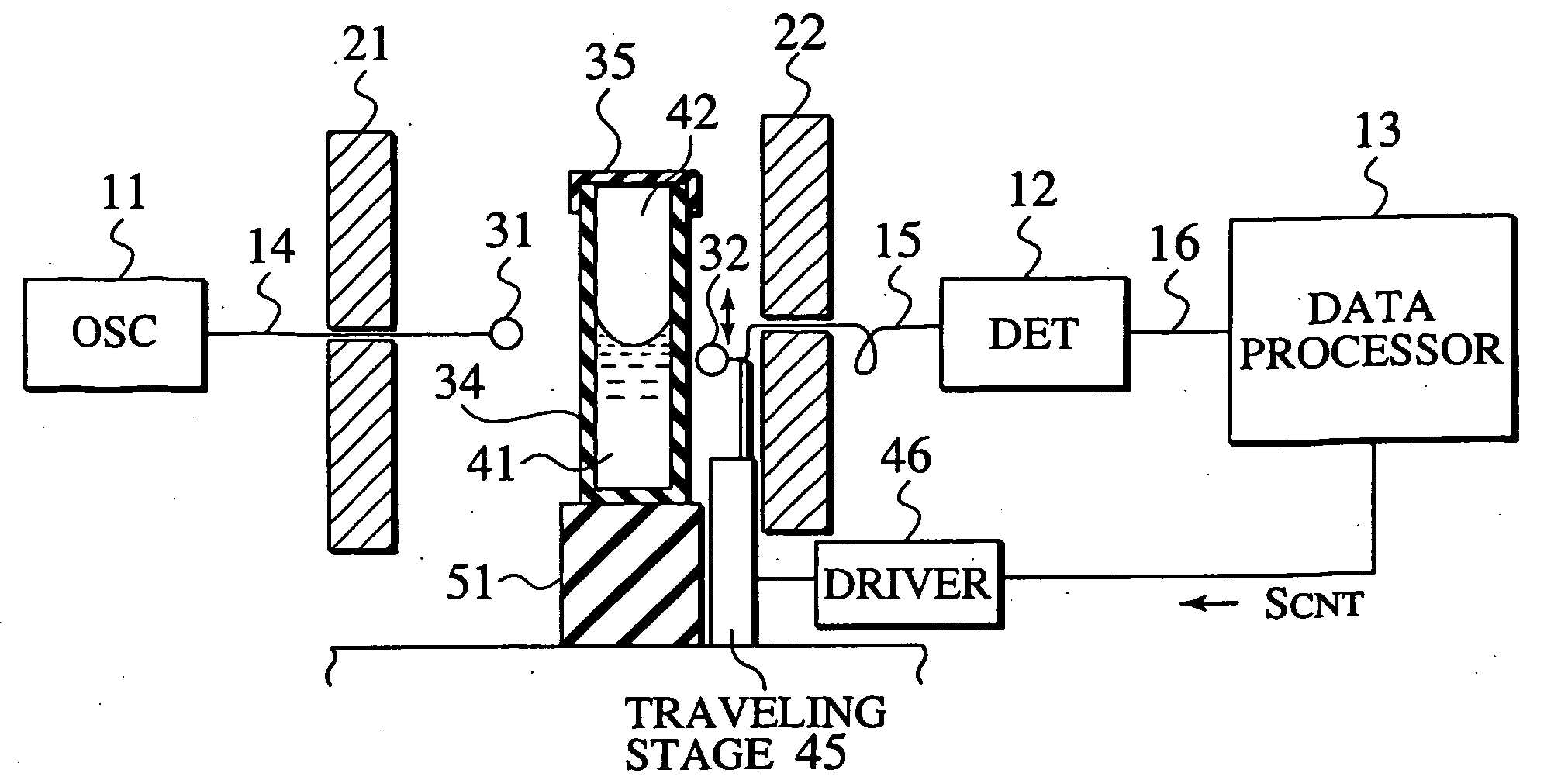Interface detection apparatus and method for detecting hidden interface using microwave
a technology of interface detection and detection apparatus, applied in the field of electromagnetic wave measurement, can solve the problem of not knowing the appropriate hidden interface detection apparatus and method
- Summary
- Abstract
- Description
- Claims
- Application Information
AI Technical Summary
Problems solved by technology
Method used
Image
Examples
first embodiment
[0033] As shown in FIG. 1A, an interface detection apparatus according to a first embodiment of the present invention encompasses an irradiation mechanism (11, 14, 31), which irradiates electromagnetic waves onto a sample (34, 35, 41, 42) having a hidden interface formed between layered materials with different physical properties, a detection mechanism (32, 15, 12), which detects electromagnetic waves that have passed through the sample (34, 35, 41, 42), and a traveling mechanism (45, 46), which changes the relative position of the hidden interface of the materials with respect to the detection mechanism (32, 15, 12). The sample (34, 35, 41, 42) includes a first material 41 and a second material 42 contained in container 34. The container 34 has a lid 35 that seals this container 34. Generally, the lid 35 does not have to completely seal the container 34. Anyhow, the lid 35 may be omitted according to circumstances or measurement specifications.
[0034] In the interface detection ap...
second embodiment
[0098] As shown in FIG. 7, in an interface detection apparatus according to a second embodiment of the present invention, a sample (34, 35, 41, 42, 43) is implemented by a first material 41, a second material 42 and a third material 43 contained in container 34. Then, a first hidden interface is formed between the first and second materials 41 and 42, and a second hidden interface is formed between the second and third materials 42 and 43. The physical properties (material constants) σi, εi, and μi (i=1, 2) for the first and second materials 41 and 42 are different from each other, and the physical properties (material constants) σi, εi, and μi (i=2, 3) for the second and third materials 42 and 43 are different from each other.
[0099] That is, the interface detection apparatus according to the second embodiment of the present invention encompasses an irradiation mechanism (11, 14, 31), which irradiates electromagnetic waves onto a sample (34, 35, 41, 42, 43) having the first and sec...
third embodiment
[0125] In the interface detection apparatus of the first embodiment, the first anti-reflection plate 21 and the second anti-reflection plate 22 are facing in parallel so as to sandwich the container 34. By enclosing the container 34 with a cylindrical anti-reflection plate (or anti-reflection cylinder) 23, the measurement accuracy and sensitivity can be improved.
[0126] As shown in FIG. 10, the interface detection apparatus according to the third embodiment of the present invention encompasses an irradiation mechanism (11, 14, 31), which irradiates electromagnetic waves onto a sample (34, 35, 41, 42) having the interface, a detection mechanism (32, 15, 12), which detects electromagnetic waves that have passed through the sample (34, 35, 41, 42), and a traveling mechanism (45, 46), which changes the relative position of the interface of the materials with respect to the detection mechanism (32, 15, 12). Similarly to the interface detection apparatus of the first embodiment, in the in...
PUM
| Property | Measurement | Unit |
|---|---|---|
| distance | aaaaa | aaaaa |
| distance | aaaaa | aaaaa |
| distance | aaaaa | aaaaa |
Abstract
Description
Claims
Application Information
 Login to View More
Login to View More - R&D
- Intellectual Property
- Life Sciences
- Materials
- Tech Scout
- Unparalleled Data Quality
- Higher Quality Content
- 60% Fewer Hallucinations
Browse by: Latest US Patents, China's latest patents, Technical Efficacy Thesaurus, Application Domain, Technology Topic, Popular Technical Reports.
© 2025 PatSnap. All rights reserved.Legal|Privacy policy|Modern Slavery Act Transparency Statement|Sitemap|About US| Contact US: help@patsnap.com



